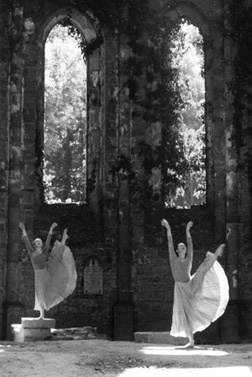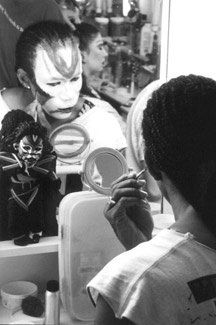 |
Introduction
As the biblical story unfolds, it does so in stories and poetry. In fact, approximately seventy-five percent of scripture consists of narrative, fifteen percent is expressed in poetic forms and only ten percent is propositional and overtly instructional in nature. In our retelling of the same story, we have reversed this biblical pattern. Today an estimated ten percent of our communication is designed to capture the imagination of the listener, while ninety percent is purely instructive.
At particular times in history, the arts have played a strategic role in the mission of the Church; at other times—when perceived to be morally and spiritual bankrupt—they were largely abandoned. However, in all probability there has never been a time in which a biblical understanding of the arts by the Church has been more needed than in our current postmodern culture with its visual and experiential orientation.
A Biblical Perspective
The Bible begins with the majestic pronouncement, “In the beginning, God created…” (Genesis 1:1). Stunning in simplicity, yet profound in implication, we are first introduced to God as the creator, the original artist. He is the creative imagination and personality behind all things; creativity is an essential part of his divine nature. God intended creation to be both functional and beautiful (Genesis 2:9). Into this world he placed the man and woman created in his image. They had the ability to think, feel and create. The cultural mandate affirms that God intended for human beings to develop and steward his world. We were commissioned to be culture formers (Genesis 1:28, 2:15).
The specific call of God for Bezalel to make “artistic designs” (Exodus 31:1-6) opens up the possibility of artistic expression as a spiritual calling. Creativity is a gift from God. The best way to thank him is to develop and use our gifts. Unfortunately, many never give themselves permission to begin to develop their creativity because it has not been encouraged or validated by the Church. Others either abandon their gifts or abandon the Church when told their artistic motivation and their faith are incompatible.
God told Moses to make a sculpture of a snake because he wanted to use this visual representation as a means to bring forgiveness, healing and restoration to his people (Numbers 21: 4-9). Other Old Testament examples abound that show how God commissioned the use of the arts in worship, to remind the people of their story or to reveal his purposes. The prophets often used stunning visual means to demonstrate God’s heart. In the New Testament, Jesus, the master storyteller, ignited the imagination of his listeners through narratives, parables and metaphors that pointed to spiritual reality.
![]()
The Role and Nature of the Arts
The beliefs and values of a community are reinforced and passed on through storytelling, poetry, dance, theatre, music and the visual arts. Artistic expressions have the ability to influence individuals and cultures in powerful ways because:
- The arts give an experience that impacts the whole person. When moved by a story we want to enter into its action and meaning.
- The arts allow us to experience events and situations we would not normally encounter, through the power of the imagination. They offer windows through which to observe some aspect of life or human experience.
- In the rush of daily life, we look at many things, but see very little. The arts can make the familiar appear unfamiliar, so that we are invited to see with fresh eyes and receive new insight.
Good art is not passive in nature. It asks something of those who engage it. Artistic expression creates a place where artist and audience meet. Thoughtful reflection is stimulated. Easy answers are avoided.
 |
Excellence of Character and Skill
When God finished his creative work, he declared it to be very good. Our gifts must be developed to reach their fullest potential. Excellence should be the hallmark of our art and our character. Humility, purity, godly accountability and the heart of a worshipper will enable the artist to overcome the distortions of idolatry, pride and sexual impurity that pervade the world of the arts.
The Arts as Witness
Should artists witness through their art? What makes a work of art an authentic witness? The biblical narrative is authentic. It is a true witness of human nature at its best and at its worst; yet it never glorifies the sin and the rebellion that it exposes. Instead, it shows God’s broken heart over his creation and points to the possibility of restoration through Christ. For art to be a truthful witness, it must be deeply authentic in its portrayal of life as we experience it, while affirming a biblical worldview.
Restoring the Arts
If God’s intention for art has been distorted, would it not be wise for the Church to avoid it altogether? Absolutely not! The arts are God's good gifts to us. We are to be involved with God in the reclamation process. The arts, though distorted by sin and idolatry (see Exodus 32 and 2 Kings 18:4), can be restored. When we fail to understand that the kingdom of God—his rule and reign—extends to every sphere of life, Christians will be discouraged from “worldly” involvement in the arts.
Examples of the Arts as Witness
Given the above understanding of the arts and how art works, the following seven personal examples and observations, while not exhaustive, will help to identify some of the ways in which the arts can express the truths of God’s kingdom.
1. Create Modern Day Parables. The play “Toymaker & Son” is an allegory of the gospel set within a world of toys. Using a non-verbal fusion of drama, dance, mime and music, this theatrical production has been able to cross national and cultural barriers. Truths creatively expressed in contemporary and meaningful parables will be key in opening the hearts and minds of our communities.
![]()
 |
2. Let the Church Celebrate! The Church should be a celebrative community that reflects the original artist that we worship and serve. All of the arts should be integrated into the whole life of the Church. They should not be just an “add-on” to the worship service.
3. Act Out Our Stories. The arts are a powerful way to move the Church to action. “Dayuma” is a theatrical reenactment of the modern mission classic told in the book Through Gates of Splendor. A powerful show in its own right, when performed in partnership with a Bible translation organization, it resulted in the completion of twenty translation projects.
4. Exchange Creative Gifts. The concept of cultural exchange in the arts can facilitate significant relationships and transformation to all involved. International Festival of the Arts has used the international language of the arts to hold large-scale, cross-cultural festivals. Over seven hundred Christians involved in the arts have participated in high profile cultural exchanges with Russian, Bulgarian and Chinese artists that enabled relationship building, respect, trust, dialogue and the expression of a biblical worldview.
5. Promote Creativity in the Christian Academy. Belhaven College, located in Jackson, Mississippi, USA, sent its dance students to China to live and exchange dance forms with the Chinese minority nationalities. This cultural exchange was reciprocated when the Chinese sent their best scholars to Belhaven, where they were exposed to a biblical worldview in their discipline.
6. Be Culture Formers, not Culture Escapers. Believers involved in the arts should seek to establish and lead credible cultural institutions, organizations and performing entities that can contribute to and influence the cultural landscape with artistic expressions that reflect a biblical worldview. A location containing an artist’s café, art studios and an art gallery, established by believer-artists in China, is now considered the place where Chinese artists in the city assemble to paint and dialogue about art, life and spiritual reality.
7. Be Salt and Light. Secular artists are “discipling the nations” because the Church has to a significant extent abandoned the marketplace. Christians should be encouraged to pursue their artistic calling within the secular culture—to be salt and light on the stage, in the art gallery or in the film industry.
Conclusion
Before the arts can take their God-ordained place within the Church and in the culture at large, there must be a recovery of a biblical understanding of the arts to the glory of God that ignites the imagination. When this happens, the calling of the artist will be affirmed, recognized and supported. The definition of evangelism and mission must be broadened from their narrow confines to embrace the full breadth of God’s redemptive purposes. He is seeking to restore all things—every area of human reality—back to his original creational intention.
Art at its best is a shared experience. There is no room for preaching or moralizing; rather, this is a place where potential revelation as truth can be uncovered and shown. The Church must celebrate its own story and creatively show it to a word-weary and biblically illiterate world.
(This article was edited from a chapter in The Complete Evangelism Guidebook. Scott Dawson, ed. 2006. Grand Rapids, Michigan, USA: Baker Books. Permission granted by author. Cannot be reproduced without permission from author.)

